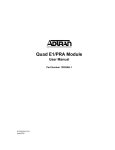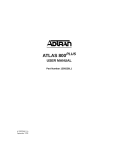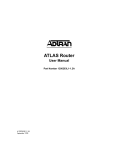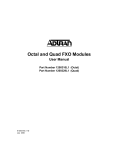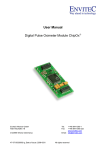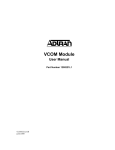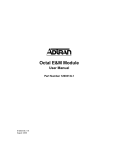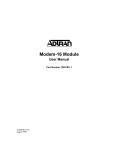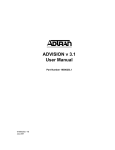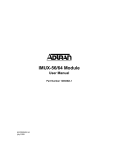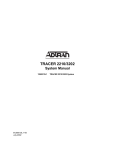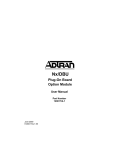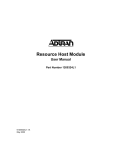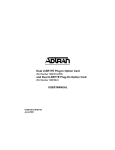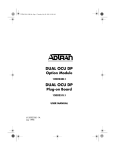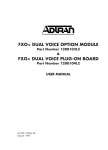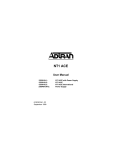Download HDLC Module User Manual
Transcript
HDLC Module User Manual Part Number 1200222L1 61200222L1-1A November1998 901 Explorer Boulevard P.O. Box 140000 Huntsville, AL 35814-4000 (256) 963-8000 © 1998 ADTRAN, Inc. All Rights Reserved. Printed in U.S.A. YEAR 2000 Compliance All ADTRAN transmission hardware and software products have been tested and found to be fully compliant with the YEAR 2000 requirements. This is true for all models and revisions regardless of the date of manufacture or delivery. Users who wish to independently verify that specific products are in compliance may contact ADTRAN Technical Support at 1-888-423-8726 for additional information. iii Federal Communications Commission Radio Frequency Interference Statement This equipment has been tested and found to comply with the limits for a Class A digital device, pursuant to Part 15 of the FCC Rules. These limits are designed to provide reasonable protection against harmful interference when the equipment is operated in a commercial environment. This equipment generates, uses, and can radiate radio frequency energy and, if not installed and used in accordance with the instruction manual, may cause harmful interference to radio frequencies. Operation of this equipment in a residential area is likely to cause harmful interference in which case the user will be required to correct the interference at his own expense. Change or modifications to this unit not expressly approved by the party responsible for compliance could void the user’s authority to operate the equipment. iv Table of Contents List of Figures ............................................................................................................... vii List of Tables................................................................................................................. vii Chapter 1 Introduction .................................................................................................................. 1-1 What is HDLC? .......................................................................................................................................... 1-1 HDLC Module Overview ........................................................................................................................ 1-1 HDLC module - when is it needed? ....................................................................................................... 1-2 ATLAS Support of HDLC Controllers ................................................................................................... 1-3 Examples Using the HDLC Module ....................................................................................................... 1-3 HDLC Module Functional Description ................................................................................................. 1-4 Features ............................................................................................................................................... 1-4 Physical Description ................................................................................................................................. 1-4 Chapter 2 Installation .................................................................................................................... 2-1 Unpack and Inspect .................................................................................................................................. 2-1 Contents of ADTRAN Shipment ..................................................................................................... 2-1 Installing the HDLC Module ................................................................................................................... 2-1 Power-Up and Initialization .................................................................................................................... 2-2 Warranty and Customer Service ............................................................................................................. 2-2 Chapter 3 Operation ...................................................................................................................... 3-1 Overview .................................................................................................................................................... 3-1 Terminal Menu Structure ........................................................................................................................ 3-1 Menu Access .............................................................................................................................................. 3-2 Menu Options ............................................................................................................................................ 3-2 Slt ................................................................................................................................................................. 3-3 Type ............................................................................................................................................................ 3-3 Menu ........................................................................................................................................................... 3-3 Alarms ........................................................................................................................................................ 3-3 Test .............................................................................................................................................................. 3-3 State ............................................................................................................................................................. 3-3 Status ........................................................................................................................................................... 3-4 Rev ............................................................................................................................................................... 3-4 Submenu Options ..................................................................................................................................... 3-4 Info Menu ................................................................................................................................................... 3-5 Part Number ....................................................................................................................................... 3-5 Serial Number .................................................................................................................................... 3-5 Board Revision ................................................................................................................................... 3-5 Status Menu ............................................................................................................................................... 3-5 DS0s Available ................................................................................................................................... 3-5 Channels .............................................................................................................................................. 3-6 Channel ID ................................................................................................................................... 3-6 61200222L1-1 HDLC Module User Manual v Table of Contents DS0s Used ....................................................................................................................................3-6 DS0 Rate, 56 / 64 K .....................................................................................................................3-6 TX Frames ....................................................................................................................................3-6 RX Frames ....................................................................................................................................3-6 Error Counters .............................................................................................................................3-7 Clr Cntr .........................................................................................................................................3-7 ATLAS Features used with the HDLC Module ....................................................................................3-7 System Self- Test ........................................................................................................................................3-7 Index ..................................................................................................................... Index-1 vi HDLC Module User Manual 61200222L1-1 List of Figures Figure 1-1. Figure 1-2. Figure 2-1. Figure 3-1. Figure 3-2. Figure 3-3. Figure 3-4. Figure 3-5. Figure 3-6. ATLAS Private Frame Relay Application ........................................................................ 1-1 HDLC Module ..................................................................................................................... 1-5 Installing the HDLC Module ............................................................................................. 2-2 Modules Menu Tree for HDLC Module .......................................................................... 3-2 Modules Menu ..................................................................................................................... 3-2 Menus Panel ......................................................................................................................... 3-5 Modules/Info Panel ............................................................................................................ 3-5 Status Submenu ................................................................................................................... 3-6 Resource Status Submenu .................................................................................................. 3-6 List of Tables Table 3-1. Management Methods for the HDLC Module................................................................. 3-1 61200222L1-1 HDLC Module User Manual vii List of Figures and Tables viii HDLC Module User Manual 61200222L1-1 Introduction Chapter 1 WHAT IS HDLC? HDLC (High-Level Data Link Control) is a synchronous, bit-oriented data link control protocol that is used extensively in wide-area networks. Because of its popularity, HDLC has been the basis for a number of other protocols including LAPD (ISDN), PPP, and Frame Relay. HDLC MODULE OVERVIEW The HDLC Module combines with other ATLAS components to implement a high-capacity HDLC resource pool in the ATLAS Integrated Access System. The HDLC Module, which occupies a single slot in the ATLAS chassis, supports 8 Mbps worth of HDLC traffic. This bandwidth is utilized through user-defined channels that range from 56 kbps to 2.048 Mbps each. Applications of the HDLC Module include private frame relay and Primary Rate ISDN (PRI) D channel implementation. Figure 11 shows a sample frame relay application using the HDLC Module. Router DDS FSU PBX PBX Router S DD FSU PBX PLUS ATLAS 800 Ethernet T1 DACS DDS FT 1 Router FSU PBX Ethernet TSU 120e DSX PBX Figure 1-1. ATLAS Private Frame Relay Application 61200222L1-1 HDLC Module User Manual 1-1 Chapter 1. Introduction HDLC MODULE - WHEN IS IT NEEDED? The HDLC Module is required for ATLAS applications requiring a large number of HDLC Controllers (the HDLC Module includes 128 HDLC Controllers). As a resource module for the ATLAS system, the HDLC Module has no external physical interfaces. All information is passed to and from the HDLC Module via the ATLAS internal backplane. Whether an HDLC module is required is determined by the user-application. An HDLC Controller is needed to process the following: • An ISDN D Channel. The HDLC Module is needed to terminate a PRI from the ATLAS T3 Module (PN 1200223L1 and 1200225L1). One HDLC controller is needed for every D Channel that ATLAS handles, regardless if it is PRI or BRI. For example, a system configured to convert a single PRI circuit into 11 BRI circuits would need 12 HDLC controllers. This can also be accomplished without the HDLC module, using the HDLC controllers that are built into the Octal BRI module and the Base Unit (assuming the PRI circuit is connected to the interface provided on the Base Unit). • An ISDN B Channel, but only if the call is being processed by ATLAS, as in the case of remote access applications. For remote access applications, one HDLC controller is required for every B Channel call that is being terminated inside ATLAS. For example, an ATLAS system configured to support a single PRI line’s worth of ISDN calls for remote access, that directs all the calls to async ports, would need 24 HDLC controllers - one for the D Channel and 23 for the B channels. In situations where ATLAS is not terminating the ISDN calls, as in the case for PRI to T1 conversion, HDLC controllers are not needed for the B Channels, just for the D Channel. ISDN calls that are directed to synchronous V.35 ports at 56 or 64 kbps do not require HDLC processing of the B channels. • A frame relay link. One HDLC controller is required for every frame relay link in an ATLAS system. For example, a single T1 connection to the public frame relay network would require one HDLC controller. In a private frame relay network, each DS0 in a T1 may represent a frame relay link to a particular remote site, in which case 24 HDLC controllers would be required. Frame relay links can be found on the DTE interface as well as the network interface. If ATLAS is passing frame relay out individual V.35 ports, each V.35 port passing frame relay is counted as a frame relay link and requires an HDLC controller. 1-2 HDLC Module User Manual 61200222L1-1 Chapter 1. Introduction ATLAS SUPPORT OF HDLC CONTROLLERS ATLAS allocates HDLC Controllers to meet the user-application requirements without user intervention. Table 1-1 describes ATLAS hardware components that include HDLC controllers. Table 1-1. ATLAS Components and Integrated HDLC Controllers Component Controllers Description ATLAS 800 Base Unit 2 Two HDLC Controllers are tied to the T1/PRI interfaces built into the Base Unit, and can be used to process D Channels when the port is configured as a PRI. ATLAS 800PLUS Base Unit 4 Two HDLC Controllers are tied to the T1/PRI interfaces built into the Base Unit and can be used to process frame relay links or D Channels when configured as a PRI. The other two HDLC controllers are general purpose and can be used to process frame relay links, D Channels, or ISDN B Channels, as required. Quad T1/PRI Module 4 Each HDLC Controller is tied to a specific T1/PRI port on the module and can only be used to process the D Channel when the port is configured as a PRI. If a T1 port on the Quad T1/PRI module is configured as a frame relay link, an HDLC controller from the 800PLUS Controller or the HDLC Module must be used. Octal BRI Module 8 These HDLC Controllers can only be used to process the D channel of the associated BRI interface. 16 These HDLC Controllers can only be used to process ISDN B Channels for remote access applications. Modem-16 Module HDLC Module 128 The HDLC Controllers on this module are general purpose and can be used to process frame relay links, ISDN B Channels, and ISDN D Channels as the system requires. EXAMPLES USING THE HDLC MODULE Some examples using the HDLC Module are listed below: 1. Remote Access - Mostly ISDN Calls For remote access applications, use the HDLC module when the majority of calls are expected to be ISDN. While it is possible to populate a system with Modem-16 Modules solely for the purpose of processing ISDN calls, a more economical route would be to install a single HDLC Module to accomplish the same task. 2. Private Frame Relay Application In a private frame relay application, you might see 24 individual frame relay links inside a T1 circuit, going to 24 different destinations. 61200222L1-1 HDLC Module User Manual 1-3 Chapter 1. Introduction This situation requires 24 HDLC Controllers and, therefore, requires the HDLC Module. 3. T3 Transporting One or More PRI Circuits When a T3 circuit is transporting one or more PRI circuits, the HDLC Module is required to process the PRIs' D Channels. Two general-purpose HDLC Controllers can terminate a PRI from the T3 as needed, if you are using the ATLAS800PLUS. HDLC MODULE FUNCTIONAL DESCRIPTION The HDLC Module installs into any available slot in the ATLAS chassis (Base Unit). The ATLAS Front Panel displays the module status. Additional status information is available via the terminal menu, accessible through either a VT-100 terminal connected to the ATLAS Base Unit’s control port, or via a Telnet session established through the Base Unit’s Ethernet port. If needed, application software necessary for the HDLC Module can be downloaded using the terminal menu. Features • Each module provides up to 8.192 Mbps of bandwidth. • Each module supports up to 128 bidirectional HDLC channels. • For each channel, bandwidth is selectable to be Nx56/64 kbps (N=1-32). • Each channel’s HDLC receiver supports flag sequence detection, bit destuffing, and CRC-16 validation. • Each channel’s HDLC transmitter supports flag sequence generation, bit stuffing, and CRC-16 generation. • Performance information such as the number of frames transmitted and received is provided on a per channel basis. • Errors that occur such as CRC errors and aborted frames are reported on a per channel basis. PHYSICAL DESCRIPTION The HDLC Module provides no external interfaces. Both the network and customer interfaces are provided on other ATLAS components. Information is passed to and from the HDLC Module via ATLAS’ internal bus. 1-4 HDLC Module User Manual 61200222L1-1 Chapter 2 Installation UNPACK AND INSPECT Carefully inspect the HDLC Module for shipping damages. If damage is suspected, file a claim immediately with the carrier and then contact ADTRAN Technical Support. If possible, keep the original shipping container for use in returning the HDLC Module for repair or for verification of shipping damage. Contents of ADTRAN Shipment The following items are included in the ADTRAN shipment: • HDLC Module • HDLC Module User Manual (insert into main ATLAS User Manual) INSTALLING THE HDLC MODULE The installation procedure is described below, and Figure 2-1 shows the proper placement of the HDLC Module. 61200222L1-1 Step Action 1 Remove the cover plate (corresponding to the slot in which the HDLC Module will be installed) from the ATLAS chassis rear panel. 2 Slide the HDLC Module into the ATLAS chassis until the module is positioned firmly against the front of the ATLAS unit. 3 Fasten the thumbscrews at both edges of the option module. 4 Install any additional modules in the Base Unit as specified in the Installation chapter of the ATLAS User Manual. HDLC Module User Manual 2-1 Chapter 2. Installation HDLC Figure 2-1. Installing the HDLC Module POWER-UP AND INITIALIZATION When the HDLC Module is inserted into the ATLAS chassis, the Front Panel STATUS indicator and ONLINE indicator are illuminated with a solid green light. Previously configured settings for the HDLC Module are automatically restored upon power-up. At this time, a system self-test can be invoked, as described in ATLAS User Manual. The TEST indicator on the Front Panel remains amber for the duration of the module self-test. Any self-test failures display in the terminal menu self-test log. WARRANTY AND CUSTOMER SERVICE ADTRAN will replace or repair this product within five years from the date of shipment if the product does not meet its published specification, or if it fails while in service. For detailed warranty, repair, and return information, refer to the ADTRAN Equipment Warranty and Repair and Return Policy Procedure (see the last page of this manual for pertinent information). A return material authorization (RMA) is required prior to returning equipment to ADTRAN. For service, RMA requests, or more information, see the last page of this manual for the toll-free contact number. 2-2 HDLC Module User Manual 61200222L1-1 Chapter 3 Operation OVERVIEW The HDLC Module menus can be viewed from two sources, as shown in Table 3-1. The ATLAS User Manual provides detailed instructions on operating each of the supported management approaches. The remainder of this chapter describes the menu items available for managing the HDLC Module using the terminal menu. Table 3-1. Management Methods for the HDLC Module Source Purpose ATLAS Front Panel For minimal configuration and status support Terminal Menu For detailed status and diagnostics You must have the appropriate password level to edit items using the terminal menu. (See the section Access Passwords in the ATLAS User Manual for detailed information on working with passwords.) Security level 1 users can view and edit every available field. Security level 5 users can view any field, but they cannot edit. Each menu description in this section indicates the required password level required for read-and-write access. TERMINAL MENU STRUCTURE ATLAS uses a form of hierarchical menus to access all of its features. The top-most menu level leads to submenus which are grouped by functionality. All submenu options display in the VT-100 terminal window. You can use the MODULES terminal menu to view the HDLC Module status and menus (see Figure 3-1). The MODULES menu option TYPE shows the HDLC Module as HDLC-128. The following sections describe the associated MODULES menu and submenus. 61200222L1-1 HDLC Module User Manual 3-1 Chapter 3. Operation Slt Type Menu Part Number Info Alarms Modules Serial Number Board Revision Test State Status Rev Status DS0s Available Channels Channel ID DS0s Used DS0 Rate TX Frames Total Errors RX Frames CRC Errors Error Counters Aborted Frames Clear Counters Invalid Frames Figure 3-1. Modules Menu Tree for HDLC Module MENU ACCESS The ATLAS System Controller automatically detects the presence of the HDLC Module when it is installed in the system. To access the MODULES menu and submenus, use the keyboard arrow keys to scroll to the appropriate row and column; then press Enter on the keyboard. For example, to view the MENUS submenu for HDLC-128, use the keyboard arrow keys to move to the row HDLC-128 and the column MENU; then press Enter on the keyboard. Refer to the ATLAS User Manual for detailed instructions on how to navigate through the terminal menu. MENU OPTIONS The following sections describe the MODULES main menu options, followed by the MODULES/MENU submenus (see Figure 3-2). Figure 3-2. Modules Menu 3-2 HDLC Module User Manual 61200222L1-1 Chapter 3. Operation > SLT Write security: 3; Read security: 5 (Slot) Displays the number of available slots in the ATLAS chassis. Slot 0 refers to the ATLAS Base Unit. > TYPE Write security: 3; Read security: 5 Displays the module type currently installed in the slot or the module type you plan to install in the slot. If an HDLC Module is installed, TYPE automatically defaults to HDLC-128 (the HDLC Module). You can use this field to preconfigure the system before installing modules by specifying the module that you want to install into each slot. If a module is installed, TYPE automatically displays the name of the installed module, and it cannot be set to any other option. > MENU Displays additional information and status submenus for the HDLC Module. To access the submenus for this item, use the arrow keys to scroll to the MENU column for the module you want to edit, and press Enter. (Submenus for this option are discussed beginning with Submenu Options on page 3-4.) > ALARMS Read security: 5 Displays whether there is an alarm condition on the HDLC Module. To view the ALARM, press Enter in this field. If no alarm conditions are available to report, this field reports [n/a]. > TEST Read security: 5 Displays whether the HDLC Module is executing a test. To activate the TEST menu, press Enter in this field. If no tests are currently available to report, this field reports [n/a]. > STATE Write security: 3; Read security: 5 Displays whether the module is ONLINE or OFFLINE. Even though a module is physically installed, it must be marked ONLINE for it to be considered an available resource. Marking an installed module OFFLINE may be useful in system maintenance or troubleshooting. If you choose OFFLINE, the module will not be in alarm condition, but will display Offline. The front panel STATUS indicator blinks green if the module has been placed OFFLINE and the ONLINE indicator turns off. 61200222L1-1 HDLC Module User Manual 3-3 Chapter 3. Operation Only if STATE reads ONLINE, can ATLAS use an installed module’s resources. > STATUS Read security: 5 Displays status information on the following: The module is enabled and is responding to the System Controller’s status polls. This is the normal response of the system. Online No Response The module is enabled but is not responding to the System Controller’s status polls. This response indicates either a problem in the system or the module is not installed. > REV Empty The System Controller has not detected the presence of a module in the option slot, nor has a module been manually enabled for this option slot. Offline The module is installed but has been taken OFFLINE by a user. The module is still responding to System Controller polls. Offline / No Response The module is installed but has been taken OFFLINE by a user. The module is not responding to polls. This response indicates either a problem in the system or the module is not installed. Read security: 5 (Hardware Revision) Displays the hardware revision of the HDLC Module . SUBMENU OPTIONS The submenus discussed here are located under the MODULES/MENU option (see Figure 3-3). You may also want to refer back to the menu tree in Figure 3-1. 3-4 HDLC Module User Manual 61200222L1-1 Chapter 3. Operation Figure 3-3. Menus Panel > INFO MENU Read security: 5 (Information) Displays information about the HDLC Module (see Figure 3-4). Figure 3-4. Info Menu » Part Number Displays the part number of the HDLC Module. » Serial Number Displays the serial number of the HDLC Module. » Board Revision Displays the printed circuit board revision of the HDLC Module. > STATUS MENU » DS0s Available 61200222L1-1 Read security: 5 Displays submenus for available resources on the HDLC Module. Displays total number of DS0s currently available for allocation on the HDLC Module (see Figure 3-5). The maximum value is 128. HDLC Module User Manual 3-5 Chapter 3. Operation Figure 3-5. Status Submenu » Channels Read security: 5 Displays status information about the resources that have been allocated on the HDLC Module (see Figure 3-6). Figure 3-6. Channels Submenu »» Channel ID Indicates the resource number of the allocated resource listed. If a number does not appear in the list, that resource is not currently allocated. »» DS0s Used Displays the number of DS0s that are being used by the resource. This value multiplied by the DS0 Rate yields the bandwidth that has been assigned to the resource. »» DS0 Rate, 56 / 64 K Displays the per DS0 rate that is being used by the resource. This value multiplied by the number of DS0s yields the bandwidth that has been assigned to the resource. »» TX Frames (Transmit Frames) Displays the number of frames that have been transmitted by this resource. CLR CNTR (Clear Counters) clears this menu item. »» RX Frames (Receive Frames) Displays the number of frames that have been received by this resource. CLR CNTR (Clear Counters) clears this menu item. 3-6 HDLC Module User Manual 61200222L1-1 Chapter 3. Operation »» Error Counters Displays the total number of errors received by the resource. Press Enter on this field to view the number of TOTAL ERRORS, CRC ERRORS, ABORTED FRAMES, and INVALID FRAMES. CLR CNTR (Clear Counters) clears this menu item. »» Clr Cntr Write security: 4; Read security: 5 (Clear Counters) Resets all counters for the channel. ATLAS FEATURES USED WITH THE HDLC MODULE In addition to the HDLC Module menu items, the SYSTEM SELF-TEST ATLAS menu item may be operated in conjunction with the HDLC Module. > SYSTEM SELF-TEST SYSTEM SELF-TEST, a submenu of the ATLAS main menu item SYSTEM UTILITY, executes both the HDLC Module and the ATLAS internal tests. The results of the self-tests are displayed in the front panel LCD or the self-test log screen of the terminal menus. For additional information on self-tests, see the ATLAS User Manual. When SYSTEM SELF-TEST displays, place the cursor on it and press Enter to execute the test. The unit continuously changes the display on the selftest log screen until all test results are shown. 61200222L1-1 HDLC Module User Manual 3-7 Chapter 3. Operation 3-8 HDLC Module User Manual 61200222L1-1 Index A H aborted frames 3-7 aborted frames errors 1-4, 3-7 accessing the menus 3-2 alarms menu 3-3 ATLAS features 3-7 ATLAS system controller 3-2 hardware revision, locating 3-4 HDLC menus 3-1 See Modules menu module features 1-4 functional description 1-4 installation procedure 2-1 installation, general information 1-4 management methods 3-1 performance information 1-4 physical description 1-4 status, viewing 1-4 receiver 1-4 transmitter 1-4 hierarchical menus 3-1 B bandwidth selectable 1-4 speed 1-4 bidirectional HDLC channels 1-4 bit destuffing 1-4 bit stuffing 1-4 board revision, locating 3-5 C CRC errors 1-4, 3-7 I DS0 rate used by resource 3-6 DS0s available 3-5 total number of 3-5 used by resource 3-6 info submenu 3-5 board revision 3-5 part number 3-5 serial number 3-5 initializing the module 2-2 installing theHDLC module, procedure for 2-1 invalid frames 3-7 items included in shipment 2-1 E M D errors aborted frames 1-4, 3-7 CRC 1-4, 3-7 F FCC statement iv FCS generation 1-4 validation 1-4 flag sequence detection 1-4 generation 1-4 Index-1 managing the HDLC module 3-1 menu tree 3-2 menus accessing 3-2 hierarchcal 3-1 moving through 3-2 structure 3-1 module type, specifying 3-3 Modules menu alarms 3-3 menu 3-3 See also info submenu HDLC Module User Manual 61200222L1-1 Index See also status submenu rev (revision) 3-4 slt (slot) 3-3 state 3-3 status 3-4 See also status menu test 3-3 type 3-3 moving through the menus 3-2 N navigating the menus 3-2 O online state 3-3 P part number, locating 3-5 password levels 3-1 R resource number 3-6 resource status 3-6 DS0 rate 3-6 DS0s 3-6 errors 3-7 aborted frames 3-7 CRC 3-7 invalid frames 3-7 total 3-7 resource 3-6 RX frames 3-6 TX frames 3-6 resource status submenu 3-6 return information 2-2 rev (revision) menu 3-4 RMA requests 2-2 RX frames 3-6 S serial number, locating 3-5 service 2-2 shipping contents 2-1 damage 2-1 slot 0 3-3 slt (slot) menu 3-3 specifying module type 3-3 state menu 3-3 status menu empty 3-4 no response 3-4 offline 3-4 offline/no response 3-4 online 3-4 status submenu 3-5 See also DS0s available See also resource status submenus info 3-5 system self-test 3-7 T terminal menu structure 3-1 test menu 3-3 tests power up 2-2 system self-test 3-7 total errors 3-7 TX frames 3-6 type menu 3-3 V viewing module status 1-4 W warranty and customer service 2-2 Y year 2000 compliance iii Index-2 HDLC Module User Manual 61200222L1-1 Product Support Information Pre-sales Inquiries and Applications Support Please contact your local distributor, ADTRAN Applications Engineering, or ADTRAN Sales: Applications Engineering (800) 615-1176 Post-sales Support Please contact your local distributor first. If your local distributor cannot help, please contact ADTRAN Technical Support and have the unit serial number available. Technical Support (888) 4ADTRAN Repair and Return If ADTRAN Technical Support determines that a repair is needed, Technical Support will coordinate with the Customer and Product Service (CAPS) department to issue an RMA number. For information regarding equipment currently in house or possible fees associated with repair, contact CAPS directly at the following number: CAPS Department (256) 963-8722 Identify the RMA number clearly on the package (below address), and return to the following address: ADTRAN Customer and Product Service 6767 Old Madison Pike Progress Center Building #6 Suite 690 Huntsville, Alabama 35807 RMA # _____________



























